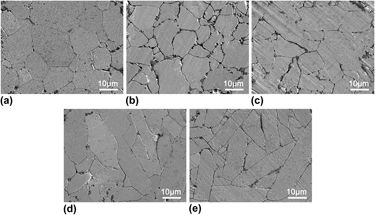Crossref Citations
This article has been cited by the following publications. This list is generated based on data provided by
Crossref.
Fang, Yuan
Liu, Xiaohua
Feng, Yuxia
Zhu, Jianfeng
and
Jiang, Wei
2020.
Microstructure and mechanical properties of Ti3(Al,Ga)C2/Al2O3 composites prepared by in situ reactive hot pressing.
Journal of Advanced Ceramics,
Vol. 9,
Issue. 6,
p.
782.
Sychev, A. E.
Gorshkov, V. A.
Karpov, A. V.
Sachkova, N. V.
Kovalev, I. D.
and
Belikova, A. F.
2021.
Synthesis and Properties of the Composite Material Based on a (V,Cr)AlC Solid Solution.
Physics of Metals and Metallography,
Vol. 122,
Issue. 3,
p.
286.
Wang, Zhenyu
Wang, Cuicui
Zhang, Yupeng
Wang, Aiying
and
Ke, Peiling
2022.
M-site solid solution of vanadium enables the promising mechanical and high-temperature tribological properties of Cr2AlC coating.
Materials & Design,
Vol. 222,
Issue. ,
p.
111060.
Tan, Qiyang
Zhuang, Wyman
Attia, Marco
Djugum, Richard
and
Zhang, Mingxing
2022.
Recent progress in additive manufacturing of bulk MAX phase components: A review.
Journal of Materials Science & Technology,
Vol. 131,
Issue. ,
p.
30.
Wang, Zhenyu
Wang, Cuicui
Zhang, Yupeng
Wang, Aiying
and
Ke, Peiling
2022.
V Solid Solution on M-Site of Cr2alc Coating Enables the Promising Mechanical and High-Temperature Tribological Properties.
SSRN Electronic Journal ,
Wang, Kaihang
Li, Zhongchang
Zhang, Yan
Ma, Guanshui
Zhou, Guangxue
Ke, Peiling
Wang, Zhenyu
and
Wang, Aiying
2024.
Solid solution of zirconium on the M-site in Ti2AlC MAX phase coatings: Synthesis, structure and mechanical properties.
Surfaces and Interfaces,
Vol. 51,
Issue. ,
p.
104678.
Zhou, Shenghao
Yuan, Jianghuai
Wu, Haichen
Wang, Kaihang
Ma, Guanshui
Zhang, Lei
Wang, Zhenyu
and
Wang, Aiying
2025.
Size-dependent uniform deformation transitions enabling hardness and toughness enhancement of nanocrystalline Cr2AlC MAX phase.
Journal of Materials Science & Technology,
Vol. 232,
Issue. ,
p.
170.
He, Nairu
Li, Jianhong
Song, Wang
Zhou, Hao
Fang, Yuan
Cai, Leping
Yang, Jie
Jia, Junhong
and
Fan, Henzhong
2025.
A new sight of tribological characterization at high temperature for V doping in Cr2AlC.
Ceramics International,
Vol. 51,
Issue. 10,
p.
12880.
